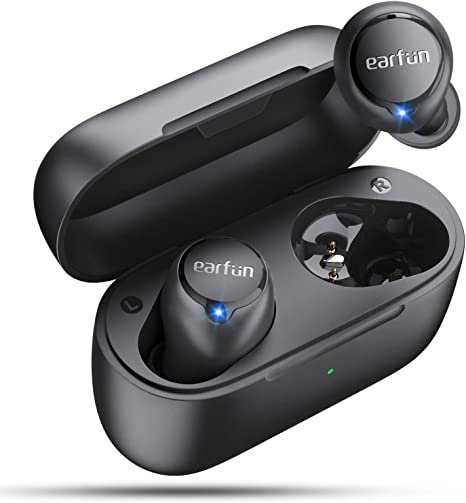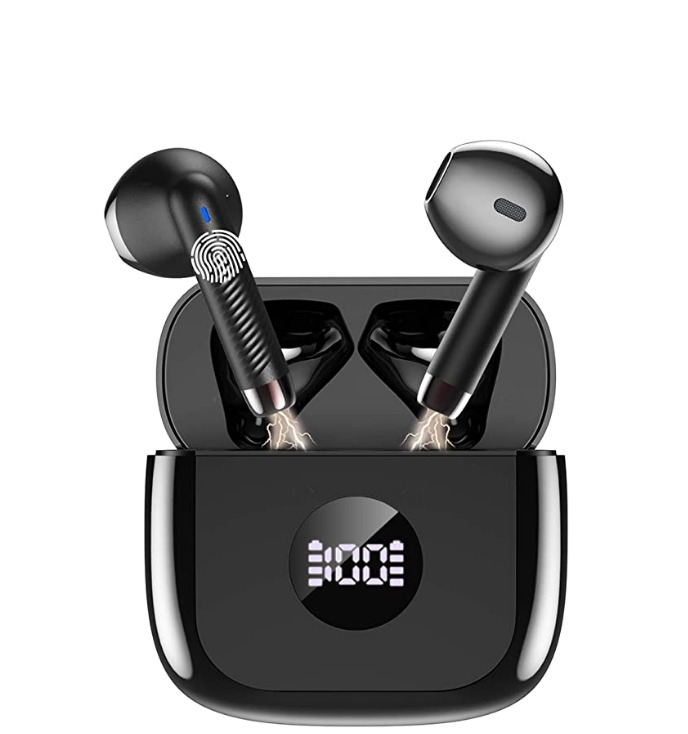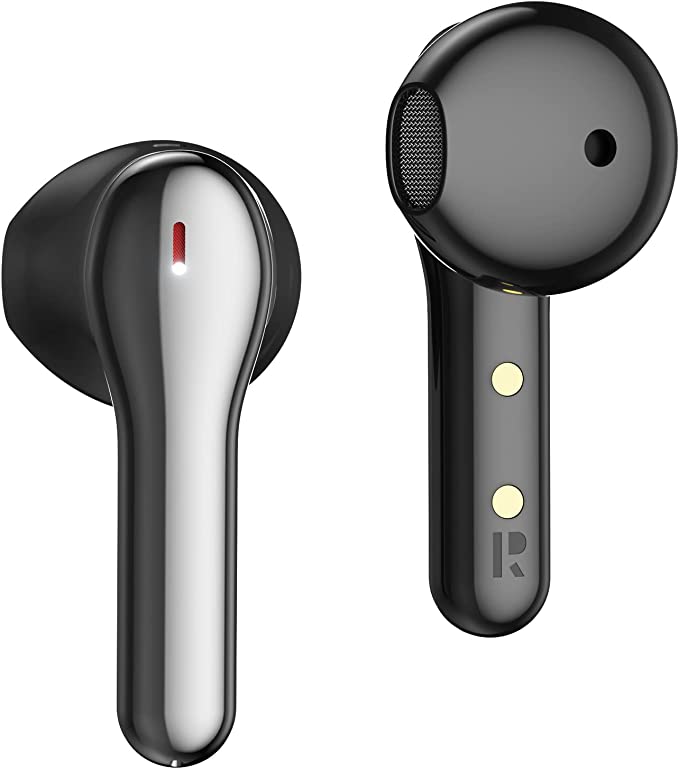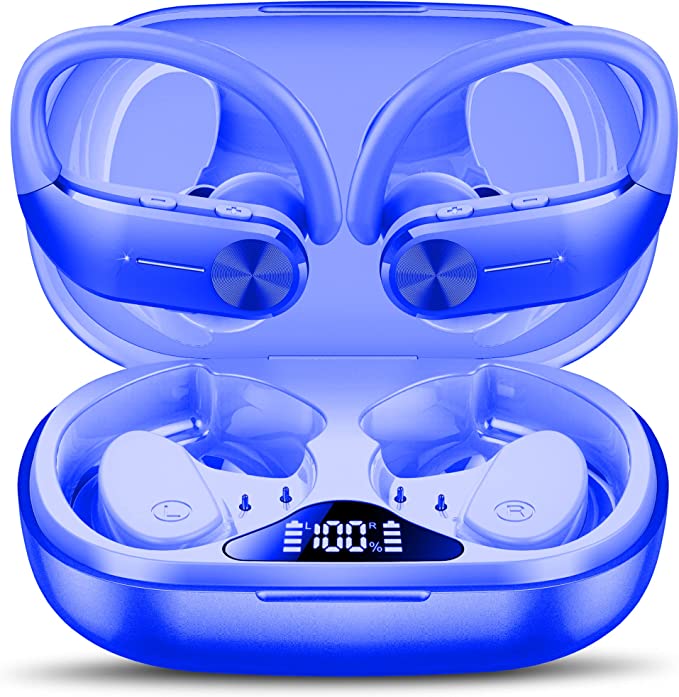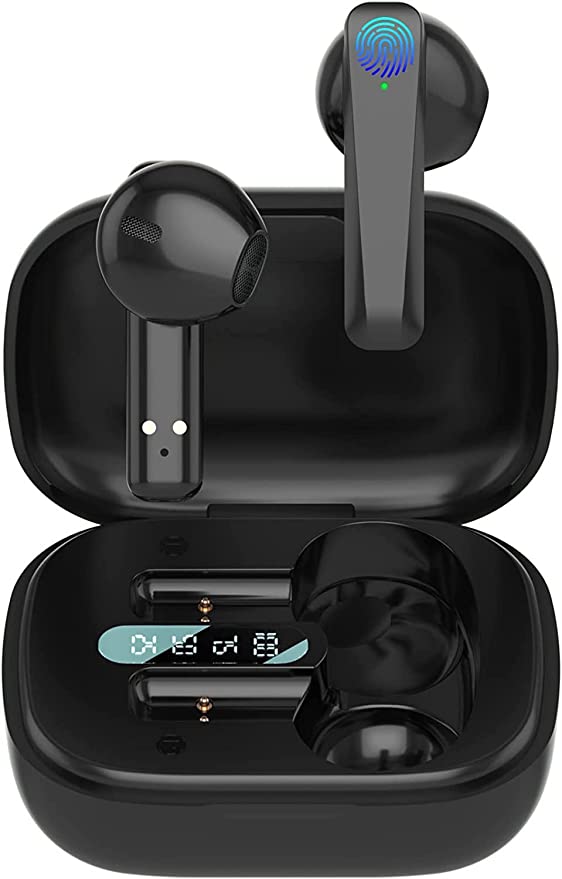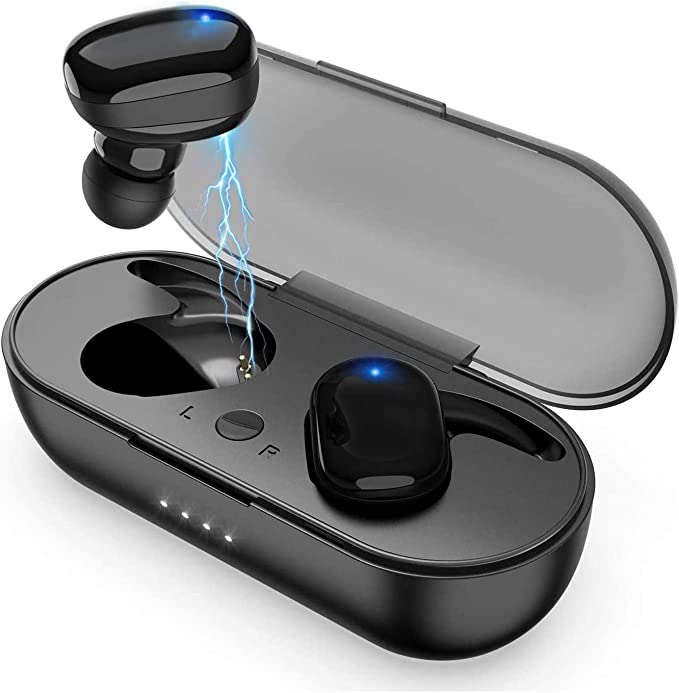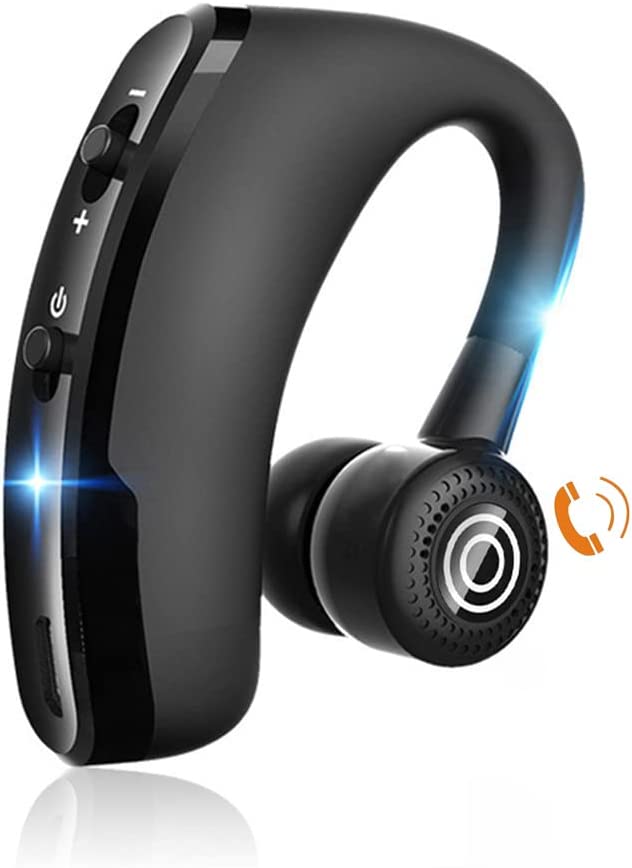EarFun TW201B Air S Earbuds: The Science of Sound, Silence, and Seamless Connectivity
Update on May 15, 2025, 8:21 a.m.
Imagine yourself in a quintessential modern soundscape: the rhythmic clatter and hiss of an espresso machine in a bustling café, the low rumble of a commuter train, or perhaps the contrapuntal symphony of a busy open-plan office. In these moments, we often yearn for a pocket of auditory peace, a bubble of immersive music, or simply the crystal clarity of an important phone call. Sound, so fundamental to our existence, is a medium we constantly navigate, filter, and seek to control. But how often do we pause to consider the intricate science and engineering चमत्कार (marvels) nestled within those tiny earbuds that have become our near-constant companions?
Let’s take a product like the EarFun TW201B Air S wireless earbuds – its product information lists a host of features like “Noise Cancelling,” “Qualcomm® aptX™,” and “4 Mics CVC 8.0 Call.” Instead of merely skimming these terms, let’s embark on a journey, as if we’re peering over the shoulder of a sound alchemist, to understand the scientific principles that breathe life into such personal audio technology. This isn’t about this specific model per se, but rather an exploration of the fascinating science these listed features represent, helping us appreciate the sophisticated dance of physics and engineering that shapes our daily listening experiences.

The Art of Silence: Navigating the Nuances of Noise Cancellation
The allure of “Noise Cancelling,” a feature highlighted for the EarFun Air S, is undeniable. In a world saturated with noise, the promise of a personal haven of quietude is incredibly appealing. But what exactly is this “art of silence,” and how is it achieved?
The quest to conquer unwanted sound isn’t new. Legend has it that Dr. Amar Bose, founder of the Bose Corporation, conceived the idea for noise-cancelling headphones during a noisy airplane flight in the late 1970s. Aviation, with its roaring engines, became one of the earliest proving grounds for this technology. At its heart, the most sophisticated form, Active Noise Cancellation (ANC), is a beautiful application of wave physics.
Imagine an unwanted sound wave – say, the drone of an aircraft engine – travelling towards your ear. ANC-equipped earbuds typically use tiny microphones, acting like vigilant sentinels, to “listen” to these incoming ambient sounds. This captured sound is then fed to an internal digital signal processor (DSP), the “brain” of the operation. This processor analyzes the waveform of the noise and, in real-time, generates an entirely new sound wave that is precisely 180 degrees out of phase with the original noise. This is the “anti-noise.” When this anti-noise is played through the earbud’s speaker, it meets the incoming ambient noise. Like two perfectly opposing forces, they effectively cancel each other out in a phenomenon called destructive interference. The result? A significant reduction in the perceived ambient sound.
There are generally two main approaches to how these microphones are placed and how the system processes the sound: “feed-forward” systems have the microphone on the outside of the ear cup, detecting noise before it reaches the ear, while “feedback” systems place the microphone inside the ear cup, hearing what the listener hears and correcting for any remaining noise. Many modern systems use a “hybrid” approach, combining both for more effective cancellation across a wider range of frequencies.
Of course, there’s also Passive Noise Cancellation (PNC), sometimes called noise isolation. This isn’t about fancy electronics but rather the physical design of the earbuds – a good seal in your ear canal, created by well-fitting ear tips, acts as a physical barrier, much like earplugs, to block out external sound. Most noise-cancelling earbuds leverage both ANC and good PNC for the best results.
The benefits for you, the listener, are manifold. On your daily commute, it can transform a cacophonous journey into an opportunity for focused work or relaxed listening. In an open office, it can be the key to deep concentration. And for travellers, it means arriving at your destination feeling less fatigued from the constant barrage of engine noise. However, the quest for perfect silence is ongoing. ANC technology is generally more effective against constant, low-frequency sounds (like engine hums or air conditioning) than it is against sudden, sharp, high-frequency sounds (like a nearby conversation or a dog bark). Wind noise can also be a challenge for the external microphones. But the advancements continue, bringing us ever closer to that coveted personal cone of silence.

The Digital Town Crier: The Science of Crystal-Clear Calls
“Can you hear me now?” It’s a phrase that has echoed through the ages of telecommunication, a testament to the perennial challenge of maintaining call clarity, especially when life doesn’t pause for us to find a quiet corner. Modern wireless earbuds, such as the EarFun Air S which lists “4 Mics CVC 8.0 Call” technology, are increasingly sophisticated in tackling this very problem. The “CVC” stands for Clear Voice Capture, a suite of algorithms developed by Qualcomm, and the “4 Mics” refers to the use of multiple microphones.
Why multiple microphones? Imagine trying to pinpoint a single voice in a crowded room – with two ears (a biological microphone array), your brain does a remarkable job of focusing on the sound source you’re interested in. Similarly, using an array of microphones allows the earbuds to perform some clever audio processing. One of the key techniques employed is often “beamforming.” Think of it as creating an invisible “listening cone” or spotlight that points directly towards your mouth, the source of your voice. The microphones work in chorus; by analyzing the slight differences in the arrival time and intensity of sound at each microphone, the DSP can preferentially amplify sounds coming from within that “beam” (your voice) while attenuating sounds arriving from other directions (background noise).
Qualcomm’s CVC 8.0 technology takes this further. It’s not just about focusing on your voice, but also actively suppressing the unwanted sounds that still make it through. The DSP employs sophisticated algorithms to identify and reduce various types of noise – the steady drone of traffic, the chatter of a café, the whir of an office fan – and even to minimize the echo of your own voice that can sometimes occur during calls.
The result for the user is a significantly clearer call experience for the person on the other end. Whether you’re closing a deal while walking down a bustling city street, coordinating with family from a busy airport, or collaborating with colleagues from your home office (which might not always be a sanctuary of silence), this technology aims to make your voice the dominant sound, not the environmental chaos surrounding you. It’s a far cry from the early days of mobile telephony, where finding a quiet spot was non-negotiable for a coherent conversation. Now, your earbuds act as your personal, intelligent digital town crier, ensuring your message is heard, loud and clear.

Wireless Fidelity: Decoding the Magic of Qualcomm® aptX™ for Richer Sound
The convenience of wireless audio, cutting the tether between our devices and our ears, is something many of us now take for granted. But this freedom comes with an inherent technical challenge: transmitting high-quality audio over the limited bandwidth of a Bluetooth connection. This is where audio codecs come into play, and Qualcomm® aptX™, a feature noted for the EarFun Air S, has a rich history in striving to enhance this wireless listening experience.
So, what exactly is a codec? The term is a portmanteau of “coder-decoder.” When you play music from your phone to your wireless earbuds, the digital audio file, which can be quite large, needs to be compressed (encoded) by your phone to be efficiently transmitted via Bluetooth. Your earbuds then need to decompress (decode) it to convert it back into an analog signal that their tiny speakers can play as sound. The most basic codec, mandated by the Bluetooth standard, is SBC (Low Complexity Subband Codec). While functional, SBC’s compression can sometimes be quite “lossy,” meaning some audio data is discarded to save space, potentially leading to a noticeable reduction in sound quality, especially for discerning listeners.
The story of aptX begins not in a corporate lab, but at Queen’s University Belfast in the 1980s, where Dr. Stephen Smyth and his colleagues developed it as part of a PhD research project. Its original aim was for professional broadcast and film audio. Later acquired by CSR, and then by Qualcomm, aptX technology was adapted and optimized for the burgeoning Bluetooth audio market.
What makes aptX (and its various iterations like aptX HD or aptX Adaptive) special is its approach to compression. It’s still a “lossy” codec, meaning some data is lost, but its algorithms are designed to be more intelligent about what data is discarded and how the remaining data is encoded. It often employs techniques related to ADPCM (Adaptive Differential Pulse Code Modulation), which essentially predicts the next audio sample based on previous ones and only transmits the difference, along with other psychoacoustic principles to minimize the perceivable impact of the compression. The goal is to achieve a listening experience that is much closer to “CD-like” quality (which typically means a bit depth of 16 bits and a sample rate of 44.1 kHz) than what basic SBC can usually offer.
For you, the listener enjoying music, podcasts, or movie soundtracks via earbuds featuring aptX, this translates to a fuller, richer, and more detailed audio experience. You might notice clearer high frequencies, more defined bass, and a greater sense of space and separation between instruments. It’s about preserving more of the nuances and subtleties of the original recording, even when listening wirelessly. While audiophiles might still debate the nuances of various codecs, technologies like aptX represent a significant step in making high-quality wireless audio an everyday reality.

The Heartbeat of Sound: Understanding 10mm Wool Composite Drivers
At the very core of any earbud or headphone, the component responsible for transforming an electrical audio signal into the mechanical vibrations that create sound waves, is the driver. The EarFun Air S product information specifies “10mm Wool Composite Drivers.” Let’s unpack what these terms mean from an acoustic and material science perspective.
First, the “10mm” refers to the diameter of the driver’s diaphragm – the thin, membrane-like part that vibrates to produce sound. In dynamic drivers, which are the most common type found in earbuds, this diaphragm is typically cone-shaped or dome-shaped and is attached to a voice coil that sits within a magnetic field. When the audio signal (an electrical current) passes through the voice coil, it creates a fluctuating magnetic force that causes the coil and the attached diaphragm to move rapidly back and forth, pushing and pulling the air to create sound waves.
Generally speaking, a larger diaphragm diameter can mean the driver is capable of moving more air. This can be beneficial for reproducing lower frequencies (bass) with more authority and less distortion. So, a 10mm driver is a respectable size for an earbud, often capable of delivering a full-bodied sound.
Now, the “Wool Composite” part is particularly intriguing. The material of the diaphragm is critical to a driver’s performance. An ideal diaphragm should be:
1. Lightweight: To respond quickly and accurately to the rapid changes in the audio signal, especially for reproducing high frequencies and transient details.
2. Stiff/Rigid: To move as a single piston without flexing or deforming, which can cause distortion, especially at higher volumes.
3. Well-damped: To prevent unwanted resonances or “break-up modes,” where parts of the diaphragm vibrate uncontrollably at certain frequencies, coloring the sound in undesirable ways.
Manufacturers experiment with a vast array of materials to achieve the best balance of these properties – from common plastics like PET and PEN, to more exotic materials like beryllium, titanium, or various composites. “Wool Composite” suggests that natural wool fibers are integrated into a matrix with other materials. Natural fibers like wool are known for their inherent self-damping properties. Think of how a wool carpet damps sound in a room. In a driver diaphragm, these damping characteristics could help to absorb unwanted resonances, potentially leading to a smoother, more natural, and less ” harsh” sound. Combining wool with other materials in a composite structure would aim to leverage wool’s damping while ensuring sufficient stiffness and lightness for good overall performance.
While the exact sonic signature depends on the entire acoustic design of the earbud (including the driver housing, nozzle, and tuning), a wool composite diaphragm might be chosen by engineers aiming for a sound that is perceived as warmer, with a more organic timbre, particularly in the midrange frequencies where voices and many instruments reside. It’s a fascinating example of how material science plays a crucial role in the art of sound reproduction, literally weaving the fabric of the sounds we enjoy.
The Seamless Symphony: Multipoint, Game Mode, and Custom EQ
Beyond the core pursuits of silence, clarity, and fidelity, modern wireless earbuds are increasingly about crafting a seamless and personalized auditory experience. Features like Multipoint Connection, Game Mode, and App-based Custom EQ, all mentioned in the context of the EarFun Air S, cater to our dynamic, multi-device, and individualistic lifestyles.
Juggling Devices, Not Connections (Multipoint Connection)
Many of us live in a multi-device ecosystem. You might be listening to a webinar on your laptop, with your smartphone nearby. What happens when a call comes in on your phone? Without multipoint, you’d typically have to manually disconnect from the laptop and connect to the phone – a minor, yet frequent, annoyance. Multipoint Bluetooth technology elegantly solves this. It allows a single pair of earbuds to maintain an active connection to two source devices simultaneously. So, in our example, the audio from your laptop webinar would play, but if your phone rings, the earbuds can automatically switch the audio source to the phone call. Once the call ends, they can revert to the laptop’s audio. This is usually managed through specific Bluetooth profiles (like A2DP for media streaming and HFP for hands-free calls) and clever firmware within the earbuds that prioritizes and switches between audio streams. It’s a subtle but powerful feature that streamlines our digital interactions.
In Sync with the Action (Game Mode)
For gamers, whether casual or competitive, audio latency – the delay between an action occurring on screen and its corresponding sound being heard through the earbuds – can be incredibly frustrating, even game-breaking. Imagine seeing an explosion before you hear it, or hearing footsteps a fraction of a second too late. “Game Mode,” as listed for the EarFun Air S, is designed to combat this. While the exact mechanisms can vary, this mode typically optimizes the Bluetooth connection and audio processing pathway to minimize this delay. This might involve switching to a lower-latency variant of a codec if available, reducing the size of audio buffers, or other proprietary optimizations. The goal is to get the Round Trip Time (RTT) for audio as low as possible, ideally well below 100 milliseconds, with some modes striving for under 50ms, to ensure that what you see and what you hear are almost perfectly synchronized, leading to a more immersive and responsive gaming experience.
Your Sound, Your Rules (App with Custom EQ)
Our perception of sound, and our preferences for how music should sound, are deeply personal. Some love a thumping bass, others prefer crisp highs, and some seek a perfectly flat, neutral response. An “App with Custom EQ” (Equalizer) empowers this personalization. An equalizer allows you to adjust the amplitude (loudness) of specific frequency bands within the audio spectrum. Think of it like the bass and treble knobs on an old stereo, but far more sophisticated. A graphic equalizer in an app might present you with several sliders, each controlling a different frequency range (e.g., 60Hz for deep bass, 1kHz for midrange vocals, 10kHz for high-frequency shimmer). By boosting or cutting these bands, you can tailor the sound signature of your earbuds to your liking, or even to suit different genres of music – perhaps a bit more bass for electronic music, or a midrange boost for podcasts to enhance vocal clarity. This journey from fixed sound profiles to user-defined sonic landscapes is a testament to the increasing desire for personalized technology.
The Unseen Current: The Simplicity of Wireless Charging
In our quest to eliminate the clutter of cables, wireless charging has emerged as a wonderfully convenient technology. The mention of “Wireless Charging” for a device like the EarFun Air S (specifically, for its charging case) taps into this modern desire for effortless power.
While the idea of transmitting power without wires has captivated inventors for over a century – with Nikola Tesla famously envisioning a worldwide wireless power system – its practical application in consumer electronics has become mainstream much more recently, largely thanks to standardization efforts like the Qi (pronounced “chee”) standard, developed by the Wireless Power Consortium.
The science behind most wireless charging pads and compatible devices is electromagnetic induction. Inside the charging pad, there’s a transmitter coil. When you place the earbud charging case (which contains a receiver coil) onto the pad, an alternating current flows through the transmitter coil, generating an oscillating magnetic field. This fluctuating magnetic field extends outwards and, when it passes through the receiver coil in the earbud case, it induces an alternating current in that coil. This induced current is then converted into direct current (DC) to charge the battery within the case.
It’s an elegant, invisible handshake of energy. No fumbling for tiny USB ports in the dark, no worn-out cables. Just place the case on the pad, and the unseen current flows. For earbuds, which are often used and recharged daily, this small convenience adds up, simplifying one more micro-interaction in our tech-filled lives and ensuring your auditory companions are always ready for your next listening session.

The Evolving Soundscape of You
The journey through the science embedded in modern wireless earbuds – from the sophisticated wave cancellation of ANC, the intelligent voice isolation of CVC, the high-fidelity ambitions of aptX, to the material science of drivers and the seamless convenience of multipoint and wireless charging – reveals a microcosm of human ingenuity. Each feature, exemplified by those listed for a product like the EarFun Air S, represents a dedicated effort to refine, control, and personalize our interaction with the world of sound.
Understanding these underlying principles does more than just demystify the technology. It transforms us into more informed listeners and consumers, allowing us to appreciate not just the final output – the music, the clear call, the quiet – but also the decades of research, the clever engineering, and the artistic considerations that make these experiences possible.
And the sonic alchemy continues. The future of personal audio whispers of even more immersive experiences like advanced spatial audio that adapts to your head movements, earbuds seamlessly integrating biometric sensors for health monitoring, and AI-driven sound personalization that learns your unique hearing profile and listening environments. As our world becomes increasingly interconnected and sonically complex, the quest to perfect our personal soundscape is more exciting and relevant than ever. The next time you pop in your earbuds, take a moment to appreciate the incredible science silently at work, orchestrating your auditory world.


